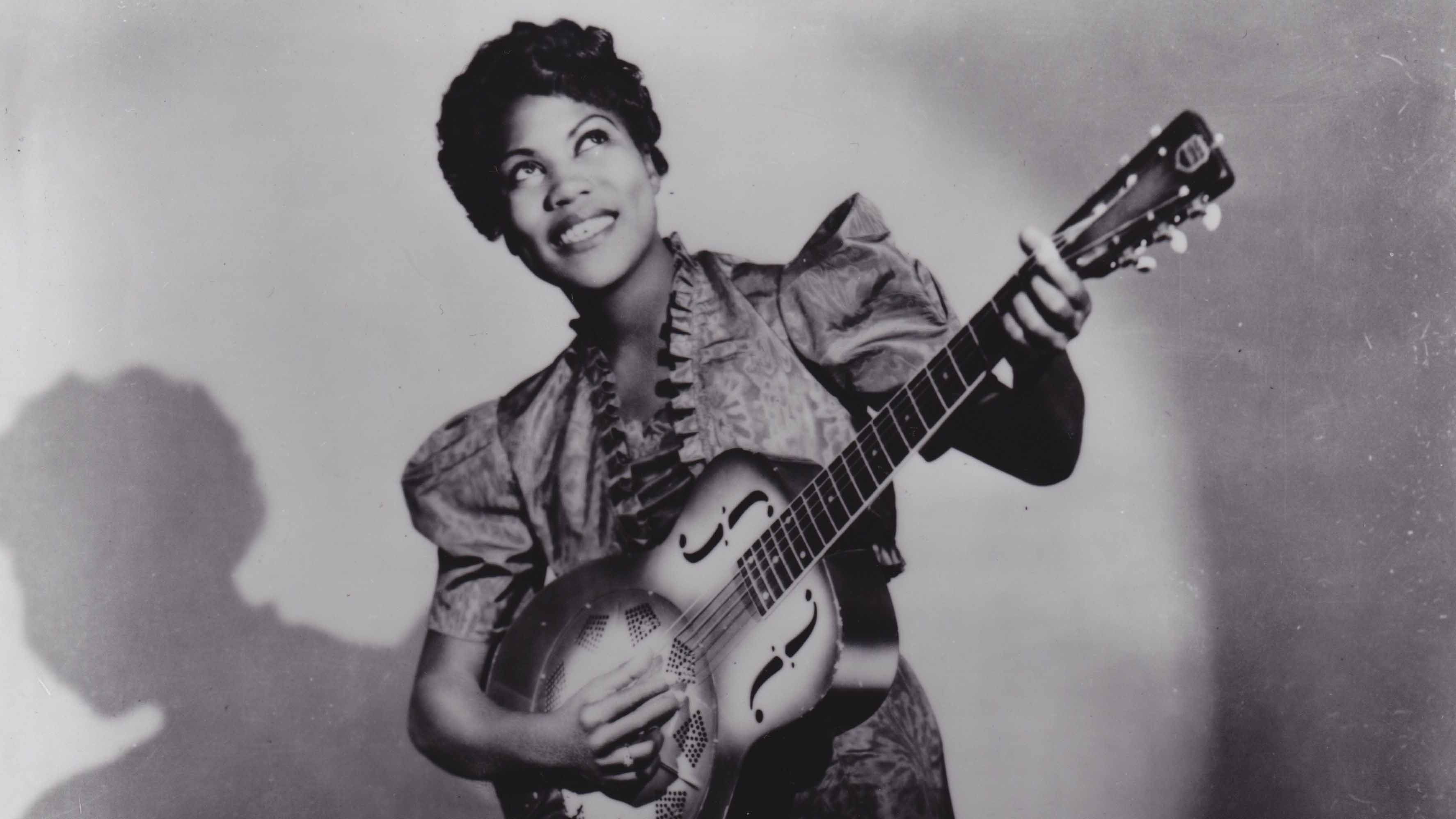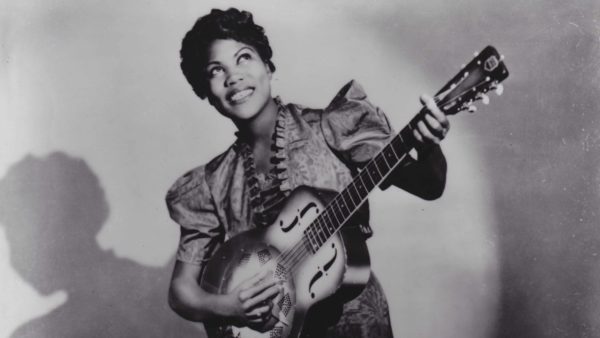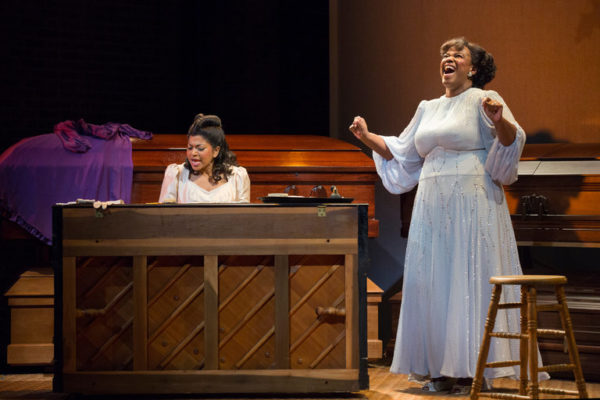
28 Sep TIO NYC: “Marie & Rosetta”
Know the name Sister Rosetta Tharpe?
I know, not a household name. (But should be.)
How about Elvis?
Thought so.
Johnny Cash, Ray Charles, and Jimi Hendrix.
Brands. Icons, right?

Sister Rosetta Tharpe.
Well, those musical titans all owe a major debt to Tharpe, (1915–1973), a legend in her time and one of the most influential artists of the 20th century. The holy rolling lady brought fierce guitar playing and swing to gospel. (Her undulating hips were her metronome.)
“Sister Rosetta Tharpe was anything but ordinary and plain. She was a big, good-looking woman and divine, not to mention sublime and splendid. She was a powerful force of nature- a guitar-playing, singing evangelist,” Bob Dylan.
Historians describe Sister (“Sister” was a nickname, not a title) Rosetta Tharpe as “The Godmother of Rock & Roll.”
Tharpe’s protégée was Marie Knight (1925–2009).
Knight was mild-mannered and had a churchier alto that blended beautifully with the older woman’s cosmic baritone. In all senses, Knight provided cover for Tharpe when they toured the country in the late -’40s.
On our first night in the Big Apple, we headed out to George Brant’s “Marie and Rosetta,” at the Atlantic’s Linda Gross Theater (through October 16).
The production is a mini double bio of the under-appreciated duo with maxi impact, largely, no entirely, because the songs — Tharpe hits “This Train,” “Up Above My Head,” and “Strange Things” — are so euphorically exciting. When Kecia Lewis sang, the audience danced in its seat.(The “conflict” between the two, however, was threadbare; scenes are simply delivering systems for the in-your-face sounds.)
Lewis, a Broadway Effie in “Dreamgirls” among many other big-shout roles, takes the role of Tharpe like a lioness on fresh kill. She’s fabulous, ferocious in her “Rock Me,” with its growling diction, just one of several numbers that blows the roof off the house.
Knight is Rebecca Naomi Jones, who evolves from modest and stiff but talented to truly sexy and sublime when she sings “I Heard My Mother Call My Name in Prayer” or dueting on the call-and-response “Up Above My Head.”
And just as hard-working as the two in front of the scrim, all hail Felicia Collins on guitar and Deah Harriott on piano, who make the show’s real sounds in Jason Michael Webb’s arrangements.
Here’s Christopher Isherwood‘s full review from the New York Times:

Rebecca Naomi Jones, left, and Kecia Lewis in the play “Marie and Rosetta,” at the Atlantic Theater Company. Credit Sara Krulwich/The New York Times.
There’s an upright piano on the stage of the Atlantic Theater Company,where “Marie and Rosetta,” a new play by George Brant, supplemented by some mighty music-making, opened on Wednesday night. But it may take awhile for you to notice, since the more striking aspect of Riccardo Hernández’s set is the array of coffins surrounding that piano, some of them draped with dresses.
The funeral home in 1946 Mississippi, where the play takes place, functions as a rehearsal room, a dressing room and, more alarmingly, a bedroom for the play’s two real-life characters: Sister Rosetta Tharpe (Kecia Lewis), a celebrated gospel and R&B singer who also played guitar and is considered an influential figure in the birth of rock ’n’ roll, and her protégée and collaborator, the younger gospel singer Marie Knight (Rebecca Naomi Jones).
As Rosetta explains to Marie, who is rattled at the news that she will be bedding down tonight in a coffin — or, if she prefers, a cot among the coffins — black performers are not welcome in public accommodations in the South of the era. “We got to be invisible,” she says. “We step offstage and we got to disappear.” A funeral home, for Rosetta, is an upgrade from the more makeshift accommodations she and her band must usually rustle up.
Mr. Brant, the author of several plays, including “Grounded,” seen at the Public Theater with Anne Hathaway (a movie starring her is in the works), has a ripe character in Rosetta, whom he depicts as a big-hearted woman of rock-firm faith who nevertheless finds room for hip-shaking and earthy humor, including a crack or two at the expense of her chief rival, Mahalia Jackson.
Rosetta and Marie have just met on the day the play takes place. Rosetta heard Marie singing on a bill with “St. Mahalia,” and is determined to bring her aboard before Mahalia can snatch her up. Today they are preparing for their first appearance together, and more broadly contemplating a longer collaboration.
As they sing, both together and individually, with Marie at the piano and Rosetta mostly on guitar (neither actress actually plays, although they mime it convincingly), Rosetta draws out the shy Marie, who’s at first awed by singing with a woman she has long admired. More important, Rosetta subtly instructs her in the dynamics of her particular kind of musicianship: gospel singing infused with the soulful power of rhythm and blues.
At first, Marie sounds as if she were performing German lieder, or at least gospel with traditional pious purity; Rosetta admires the beauty of her sound and her playing, but has other plans, beginning with eliminating the “vibrator” from her delivery, and infusing some “swing” into her piano playing. “Your piano’s an old maid with a gray tabby on her lap,” Rosetta says bluntly. “You need a little more barrelhouse in there.”
For a late-dinner that night, we strolled down the block to Tia Pol, 205 Tenth Avenue (between 22nd & 23rd streets), a favorite lunch hang when we explore galleries in Chelsea and just as good for dinner. Tia Pol takes an unapologetically authentic approach to regional Spanish food, serving up small-plate, sizzling delights.


Sorry, the comment form is closed at this time.